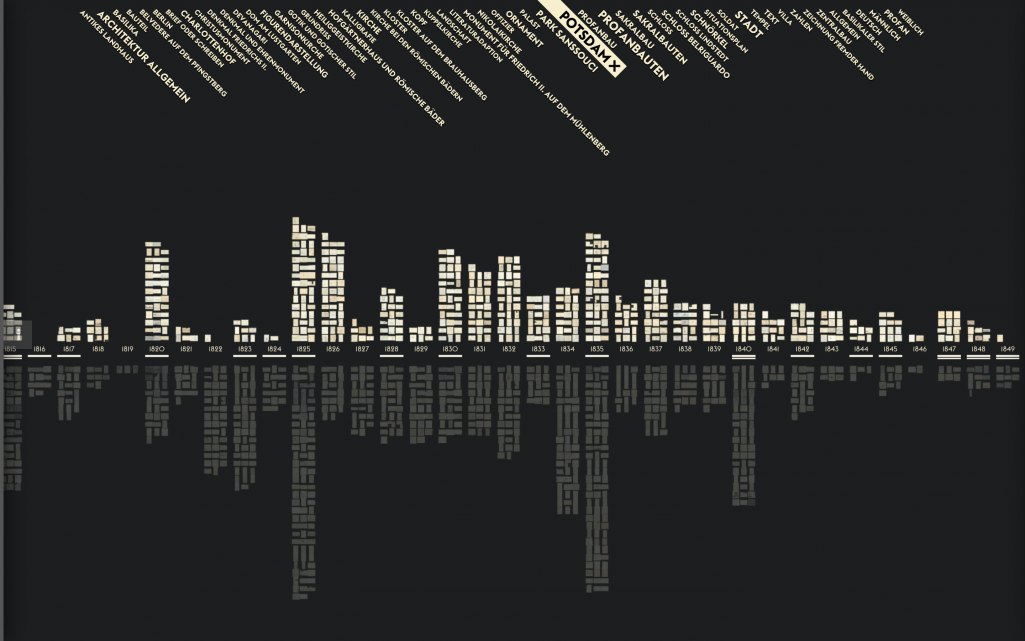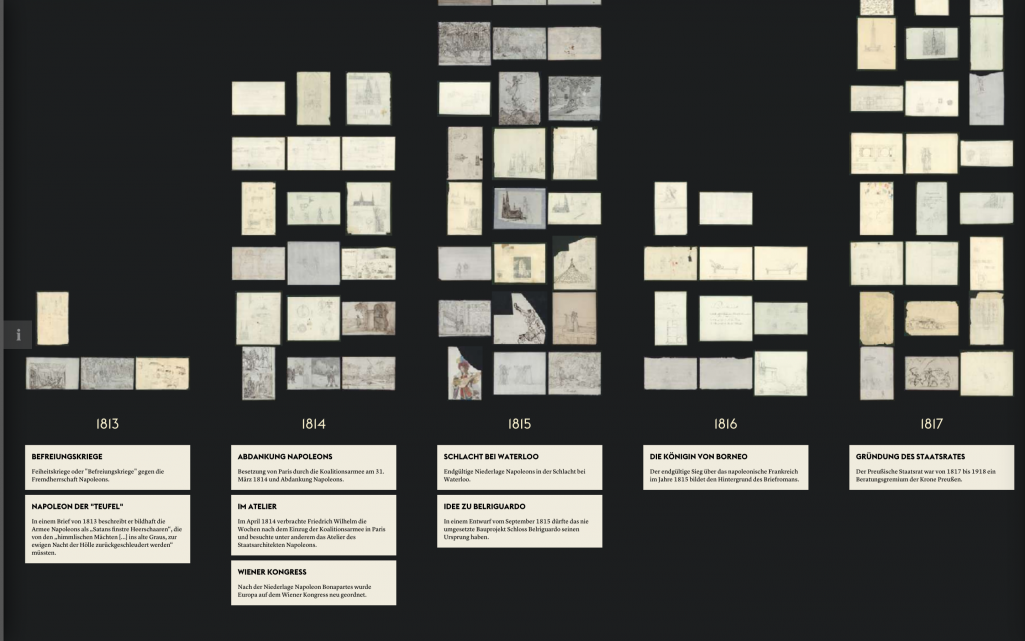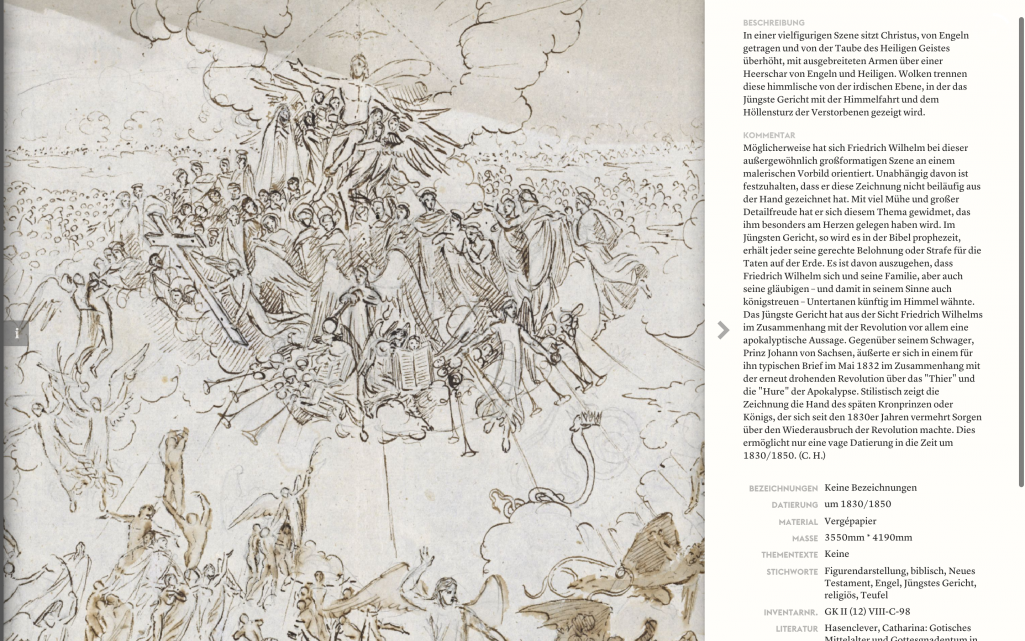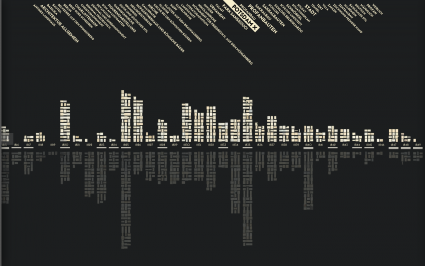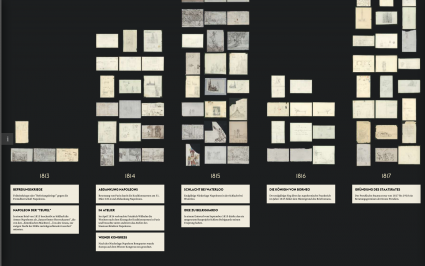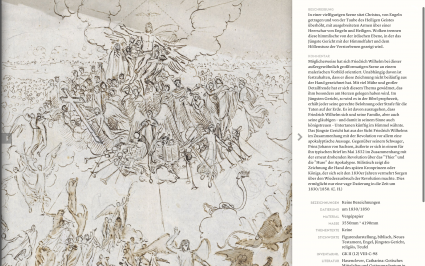Frederick William IV of Prussia (1795 – 1861) left a collection of drawings behind. They bear witness to historical events such as wars and revolutions, literary influences or personal obsessions with the devil. Numerous sheets reveal the planning eye of the King in the form of architectural visions and dreamy drafts. So far, 1492 sheets of drawings penned by the King have been fully accessed. In the framework of the research project “VIKUS”, a visualisation has been developed that highlights thematic and historical connections within the drawings and makes them available for exploration in high resolution.
The drawings by Frederick William IV are part of the collection of prints and drawings of the Prussian Palaces and Gardens Foundation Berlin-Brandenburg and have previously been published in a online inventory catalogue. Project partners of the research project »VIKUS – Visualising Cultural Collections«, which is funded by the Federal Ministry of Education and Research, are the Prussian Palaces and Gardens Foundation Berlin-Brandenburg (SPSG) and the Programmfabrik GmbH. The visualisation is based on an online inventory catalogue of the drawings by Frederick William IV of Prussia. It was published in 2013 by the Prussian Palaces and Gardens Foundation Berlin-Brandenburg (SPSG). The timeline information was supplemented with excerpts from the exhibition catalogue »Unglaublich ist sein Genie fürs Zeichnen« Friedrich Wilhelm IV. von Preußen (1795-1861) zum 150. Todestag, published on behalf of the Prussian Palaces and Gardens Foundation Berlin-Brandenburg by Jörg Meiner, 2011.
TECHNOLOGY
HTML5, CSS3, Canvas/WebGL, pixi.js und d3.js
Publications
Associated Publications
—
in: Konferenzband zur 22. Berliner Veranstaltung der internationalen EVA-Serie: Electronic Media and Visual Arts,
2015
Im Rückgriff auf Ausstellungspraktiken im Museum stellt der Artikel Bezüge zwischen Erkenntnissen aus der Visualisierungsforschung und der Rezeption von Museumssammlungen in einem Ausstellungsdisplay her. Besondere Beachtung finden hierbei Makro- und Mikroperspektiven auf Sammlungen und Darstellungen im (digitalen) Display eines Museums. Visualisierungen können einen offenen und explorativen Zugang zu den digitalisierten Beständen bieten, der eher den Ausstellungs- und Vermittlungsaktivitäten des Museums entspricht oder diese ergänzt. Dabei werden die Potenziale der digitalen Präsentation herausgearbeitet und Anhand von Use Cases aus der Forschung illustriert, welche Ansätze in der facettierten und „kuratierten“ Inszenierung von Sammlungen umgesetzt werden können.
Expand
—
in: Konferenzband zur DHd 2017 Bern - Digitale Nachhaltigkeit,
2017
Die Entwicklung digitaler Werkzeuge lässt sich als wichtiger Teilbereich in den Digital Humanities identifizieren (Davis und Kräutli 2015; Schnapp et al. 2009). Entsprechende Forschung und Projektarbeit steht dabei komplexen Herausforderungen gegenüber. Nicht nur die Frage nach verfügbaren Daten, methodologischer Fundierung und technologischer Umsetzbarkeit, sondern auch die Frage nach deren langfristigen Verfügbarmachung sind wiederkehrende Themen der letzten Jahre. Eine zentrale Rolle für die Sicherstellung von Qualität und Anwendbarkeit der digitalen Werkzeuge ist die Einbindung von Forscher_innen der jeweiligen geisteswissenschaftlichen Disziplinen im Entwicklungsprozess (Drucker 2013). Gleichzeitig lässt sich die zentrale Bedeutung von Interfacedesign, Nutzungsanleitungen und Benutzerfreundlichkeit als wichtige Faktoren für die Etablierung von digitalen Werkzeugen im Forschungsprozess feststellen (Gibbs und Owens 2012). Doch selbst wenn diese Herausforderungen bewältigt werden und ein digitales Werkzeug (erfolgreich) entwickelt wurde, stellt sich weiterhin die Frage, wie die langfristige Nachnutzung im Sinne einer digitalen Nachhaltigkeit sichergestellt werden kann. Am Beispiel des Entstehungsprozesses einer sammlungsspezifischen Visualisierung und deren Weiterentwicklung zu einem nachnutzbaren Werkzeug werden einige zentrale Aspekte der beeinflussenden Faktoren und Lösungsansätze vorgestellt. Unser Beitrag stellt sich somit der Frage, wie sichergestellt werden kann, dass digitale Tools auch über die Laufzeit von Förderprojekten hinaus (und unabhängig von spezifischen Use-cases) dauerhaft nutzbar und weiterentwickelbar sind.
Expand
—
in: International Journal for Digital Art History; No 2,
2016
In this article we present a case study on digital representation of the art historical research and metadata brought together for a scientific collection catalogue by the Prussian Palaces and Gardens Foundation Berlin-Brandenburg. The resulting interface aims at linking the structure and texture of a collection of drawings by Frederick William IV of Prussia (1795–1861) with additional contextual information. The article describes the context of the larger research project and presents the resulting visualization and interaction techniques specifically designed for dynamic exploration along time and subjects.
Expand
—
DHQ: Digital Humanities Quarterly. 11:2,
2017
We present a case study on visualizing a collection of historic drawings along its metadata structure while also allowing for close examination of the artifacts’ texture. With regards to the specific character of cultural heritage at the intersection of research, education, and public interest, the presented visualization environment aims at meeting the requirements of both researchers as well as a broader public. We present the results from a collaborative interdisciplinary research project that involved a cultural heritage foundation, art historians, designers, and computer scientists. The case study examines the potential of visualization when applied to, and developed for, cultural heritage collections. It specifically explores how techniques aimed at visualizing the quantitative structure of a collection can be coupled with a more qualitative mode that allows for detailed examination of the artifacts and their contexts by displaying high-resolution views of digitized cultural objects with detailed art historical research findings. Making use of latest web technologies, the resulting visualization environment allows for dynamic filtering and zooming of a collection of visual resources that are arranged along a contextualized timeline. We share insights from our collaborative design process and the feedback and usage data gathered during the deployment of the resulting prototype as a web application. We end with a discussion of transferability of carefully crafted and collaboratively negotiated visualizations of cultural heritage and raise questions concerning the applicability of our approach to related strands of humanities research.

